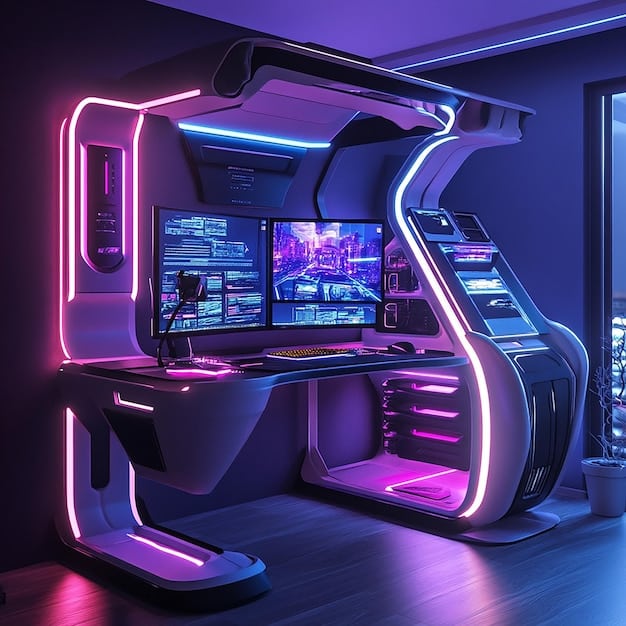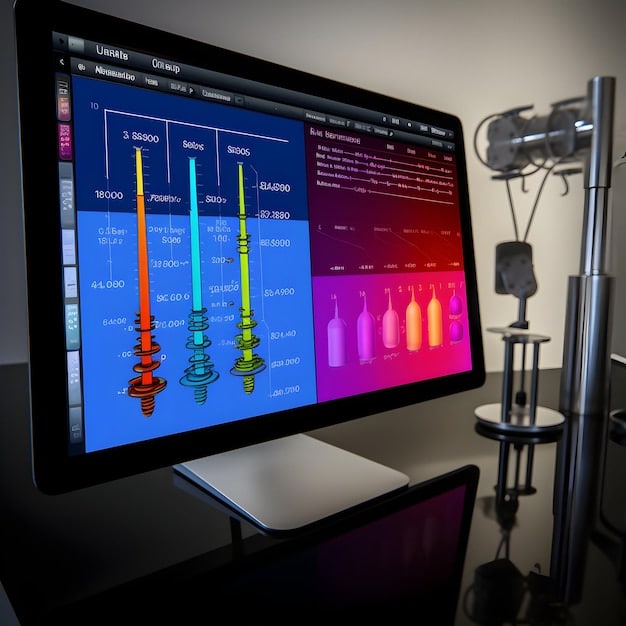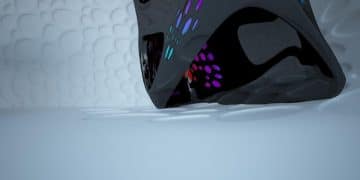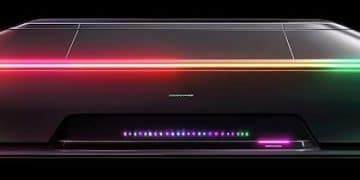Is Your Gaming PC Ready for 2025 Ray Tracing Revolution?

The 2025 ray tracing revolution demands a powerful GPU, sufficient VRAM, and a high-performance CPU to deliver immersive, realistic graphics and maintain smooth frame rates, necessitating current system benchmarks to assess upgrade readiness.
The gaming landscape is constantly evolving, with new technologies pushing the boundaries of visual fidelity. By 2025, ray tracing will likely be an indispensable feature in most AAA titles, fundamentally altering how light, shadows, and reflections are rendered. This raises a crucial question for every enthusiast: Is Your Gaming PC Ready for the 2025 Ray Tracing Revolution? Benchmark Your System Now to understand where you stand before the next wave of graphical demands hits.
Understanding the Ray Tracing Revolution
The arrival of hardware-accelerated ray tracing marked a significant leap in graphics technology, moving beyond traditional rasterization to simulate light more accurately. This revolution, starting years ago, is set to culminate by 2025, with games expected to fully leverage ray tracing capabilities, making it a standard rather than a niche feature. This means that merely running a game will no longer suffice; experiencing it with intended visual fidelity will demand ray tracing.
Hardware manufacturers such as NVIDIA and AMD have been investing heavily in dedicated RT (Ray Tracing) cores and accelerated architectures. These advancements are not just about making games look better; they’re about creating deeply immersive worlds where every reflection, shadow, and global illumination effect is rendered with photorealistic precision. The widespread adoption of these technologies in game engines and developer toolkits suggests that by 2025, games built without a strong emphasis on ray tracing will be the exception, not the rule. The challenge for gamers is ensuring their systems can keep pace with these escalating demands without significantly compromising performance.
What is ray tracing and why it matters
Ray tracing is a rendering technique that simulates the physical behavior of light. Instead of just drawing polygons, it traces rays of light from the camera into the scene, simulating how they bounce off surfaces, get refracted, and cast shadows. This results in incredibly realistic lighting, reflections, and refractions, making game worlds feel more alive and immersive. It matters because it creates a level of visual realism previously unimaginable in real-time gaming, blurring the line between virtual and reality.
The evolution of ray tracing technology expected by 2025
By 2025, expect advancements beyond current implementations. We are likely to see more sophisticated ray tracing algorithms that require less computational power while delivering even better visual quality. This includes accelerated global illumination, path tracing (a more advanced form of ray tracing), and potentially even real-time constructive solid geometry (CSG) rendered with ray tracing. These improvements will make ray tracing less of a performance drain and more of an integrated, seamless part of the gaming experience.
Key Hardware Components for Peak Ray Tracing Performance
To truly immerse yourself in the ray tracing revolution, specific hardware components are paramount. These aren’t just about raw power; it’s about specialized architectures designed to handle the intricate calculations that ray tracing demands. Understanding the role of each component can help you identify potential bottlenecks in your current system and prioritize upgrades.
At the heart of ray tracing lies the GPU, but it’s not alone. The CPU plays a crucial role in feeding data to the graphics card efficiently, and memory, both system RAM and VRAM, ensures there are no slowdowns in loading complex scenes. Overlooking any one of these can significantly impact your ray tracing experience, turning a visually stunning game into a stuttering mess. Therefore, a holistic view of your system’s capabilities is essential when considering its readiness.
The pivotal role of the graphics card (GPU)
The GPU is undoubtedly the most critical component for ray tracing. Modern cards from NVIDIA (RTX series) and AMD (RX 6000/7000 series and above) feature dedicated hardware for ray tracing acceleration, known as RT Cores or Ray Accelerators. These specialized units offload the intense computations from the main shader cores, enabling real-time ray tracing without grinding frame rates to a halt. A powerful GPU with ample VRAM is non-negotiable for 2025’s graphically demanding titles.
* NVIDIA RTX Series: Known for superior RT performance due to dedicated RT Cores.
* AMD Radeon RX Series: Offers competitive RT performance with its Ray Accelerators.
* VRAM Capacity: Essential for handling detailed textures and complex scene data in ray-traced environments, typically 12GB or more for high resolutions.
CPU and RAM: The unsung heroes
While the GPU handles the bulk of ray tracing calculations, the CPU and RAM ensure the rest of your system can keep up. A fast multi-core CPU is necessary to process game logic, AI, and draw calls, feeding the GPU with data efficiently. Without a capable CPU, even the most powerful GPU can be bottlenecked, leading to lower frame rates. Adequate and fast RAM (typically 16GB-32GB of DDR4 or DDR5) is crucial for loading game assets quickly and preventing stutters, especially in open-world titles with extensive draw distances.
Storage solutions: SSDs are a must
Traditional hard drives (HDDs) are a major bottleneck for modern gaming, especially with the large game files and fast asset streaming required for ray tracing. A fast NVMe SSD is essential for quick loading times, seamless texture streaming, and overall system responsiveness. DirectStorage, a technology that allows the GPU to decompress game assets directly from the SSD, will become increasingly important, further reducing CPU overhead and improving loading times in next-gen games.
Benchmarking Your Current System: Tools and Techniques
Before you can determine if your PC is future-proofed for 2025’s ray tracing revolution, you need to understand its current capabilities. Benchmarking is the diagnostic process that reveals your system’s strengths and weaknesses, providing concrete data rather than anecdotal observations. It helps you quantify performance, identify bottlenecks, and make informed decisions about potential upgrades.
Benchmarking isn’t just about running a single test; it involves a combination of dedicated software, in-game benchmarks, and real-world gameplay analysis. This comprehensive approach ensures you get a complete picture of how your system performs under various loads. Relying solely on synthetic benchmarks might not reflect actual gaming performance, while only playing games might not pinpoint the exact cause of performance issues.

Synthetic benchmarks for ray tracing capabilities
Synthetic benchmarks are specialized programs designed to push your hardware to its limits, often with specific workloads that mimic game scenarios. For ray tracing, these tools are invaluable. They provide standardized scores that allow you to compare your system’s performance against others and identify raw ray tracing power.
* 3DMark Port Royal / Speedway: These benchmarks from UL Solutions are industry standards for testing ray tracing performance. Port Royal focuses on general ray tracing, while Speedway introduces global illumination and other advanced effects. They provide a clear numerical score.
* Unigine Superposition Benchmark: While not exclusively ray tracing focused, Superposition can be used to gauge overall GPU performance and stability, which indirectly impacts ray tracing readiness.
* Heaven Benchmark: An older but still relevant benchmark for overall GPU stability and comparing performance across different hardware configurations under DirectX 11.
In-game benchmarks: Real-world performance insights
Many modern games include built-in benchmarks that can give you a more accurate representation of how your system performs with actual game engines and assets. These are particularly useful for assessing ray tracing performance in specific titles. Look for games like Cyberpunk 2077, Control, Metro Exodus Enhanced Edition, or Marvel’s Spider-Man Remastered, as they offer robust ray tracing implementations and integrated benchmarking tools. Running these benchmarks with and without ray tracing enabled will highlight the performance impact, providing crucial data for your upgrade considerations.
Monitoring tools for deeper analysis
Beyond benchmarks, real-time monitoring tools provide invaluable insights into how your components are performing during gameplay. Tools like MSI Afterburner, HWMonitor, or CapFrameX allow you to track GPU usage, CPU usage, VRAM consumption, clock speeds, temperatures, and frame rates. High CPU usage combined with low GPU usage might indicate a CPU bottleneck, while maxed-out VRAM could suggest a need for a GPU with more memory.
* GPU Usage: Indicates how much your graphics card is being utilized.
* CPU Usage: Shows processor workload; uneven core usage can pinpoint bottlenecks.
* VRAM Consumption: Critical for ray tracing; hitting VRAM limits causes performance drops.
* Frame Rate (FPS) and Frametime: Measures smoothness; consistent high FPS and low frametimes are ideal.
Interpreting Benchmark Results and Identifying Bottlenecks
Once you’ve run the benchmarks, the raw numbers are just that: numbers. The real skill lies in interpreting them to understand what they mean for your system’s readiness for next-gen ray tracing. This involves comparing your results to established baselines, understanding the implications of different metrics, and pinpointing exact areas where your system might be falling short.
This analytical step is crucial. Without proper interpretation, you might misunderstand a strong CPU score for overall system strength, when in fact, your GPU might be struggling with ray tracing. Or, you might find your GPU performs well, but sporadic stutters indicate an underlying issue with RAM or storage. A detailed look at the combined data is essential for making informed upgrade decisions.
Understanding your scores: Good, average, or struggling?
Compare your synthetic benchmark scores (e.g., 3DMark Port Royal) with online databases of similar hardware configurations. This provides a clear context. For in-game benchmarks, aim for a consistent minimum of 60 frames per second (FPS) at your desired resolution with ray tracing enabled. If your average FPS is consistently below 30-45 FPS, especially with ray tracing, your system is likely struggling. Consistently high frame times (measured in milliseconds) indicate stuttering, even if the average FPS seems acceptable.
Pinpointing hardware bottlenecks
Analyzing your monitoring tool data during gameplay or benchmarks is key to identifying bottlenecks.
* GPU Bottleneck: If your GPU usage is consistently at 95-100% while your CPU usage is low (e.g., below 70-80%), it suggests your GPU is the limiting factor. This is often the case with ray tracing due to its graphical intensity.
* CPU Bottleneck: If your CPU usage (especially a few cores) is high (e.g., nearing 100%) while your GPU usage is lower (e.g., 60-80%), your CPU is likely not feeding the GPU fast enough.
* VRAM Bottleneck: If your VRAM is consistently maxed out (indicated by a high VRAM usage percentage) and you experience stutters or texture pop-in, you need a GPU with more video memory.
* RAM Bottleneck: If your system RAM usage is consistently high (e.g., >85%) and you notice game stutters or OS unresponsiveness, more system RAM might be needed.
Prioritizing upgrades based on your findings
Once you’ve identified your bottlenecks, you can prioritize intelligent upgrades.
1. GPU: If your GPU is the primary bottleneck for ray tracing, it’s the most logical and impactful upgrade. Look for cards with superior RT performance and ample VRAM (e.g., NVIDIA RTX 4070/4080/4090 or AMD Radeon RX 7800 XT/7900 XT/7900 XTX or newer generations).
2. CPU: If your CPU is bottlenecking your high-end GPU, consider upgrading to a newer generation processor with more cores and higher clock speeds.
3. RAM: If you have less than 16GB RAM, upgrading to 16GB or 32GB (preferably fast DDR4 or DDR5) will improve overall system fluidity.
4. SSD: Ensure your OS and primary games are on an NVMe SSD for fast loading.
Future-Proofing Strategies for 2025 and Beyond
Looking ahead to 2025, future-proofing your gaming PC isn’t just about buying the most expensive components today; it’s about making smart, informed decisions that anticipate future technological trends. With ray tracing becoming standard, and other advanced rendering techniques on the horizon, a strategic approach to upgrades is essential.
This involves not only focusing on raw power but also on compatibility, efficiency, and adaptability. Investing in a platform that allows for incremental upgrades, rather than requiring a full system overhaul every few years, can save both money and headaches. Understanding where technology is heading allows you to make purchases that remain relevant for a longer period, extending the lifespan of your gaming rig.
Investing in the right GPU: Power and VRAM
As established, the GPU is king for ray tracing. For 2025, aim for graphics cards that not only perform well in current ray tracing benchmarks but also offer significant VRAM (16GB or more) to handle the increasingly detailed textures and complex scenes of future games. Consider cards with robust cooling solutions and efficient power delivery, as next-gen GPUs will likely continue to increase in power consumption.
* Prioritize current-gen or next-gen cards: Avoid older generations that lack sufficient RT core performance.
* VRAM is non-negotiable: Ensure at least 16GB for high-resolution ray tracing.
* Cooling: A robust cooling system is crucial for sustained performance in demanding titles.
Exploring CPU platforms and memory innovations
Choosing the right CPU platform means looking beyond just the processor itself. Consider motherboards that support the latest PCIe generations (e.g., PCIe 5.0) for future GPU and NVMe SSD compatibility, as well as support for DDR5 RAM. While DDR5 is currently more expensive, its increased bandwidth will become increasingly important for high-refresh-rate gaming and data-intensive applications. Investing in a platform that supports new CPU generations also allows for easier future upgrades without replacing the entire motherboard.
Connectivity and ecosystem considerations
Future-proofing also extends to connectivity. Wi-Fi 6E/7, Bluetooth 5.3+, and multiple high-speed USB ports (Type-C with Thunderbolt support) are essential for a modern gaming setup. Furthermore, consider the ecosystem: are you committed to NVIDIA’s DLSS or AMD’s FSR? Both are crucial for performance scaling with ray tracing, and your choice might influence your GPU brand loyalty. An integrated ecosystem often provides a smoother overall experience, including driver support and software features.
Optimizing Your Settings for Ray Tracing
Having a powerful system is only half the battle; knowing how to optimize your game settings is the other. Ray tracing can be incredibly demanding, and even on high-end hardware, you may need to tweak a few options to maintain a smooth and enjoyable experience. This isn’t about compromising visual quality entirely, but rather finding the sweet spot where stunning visuals meet acceptable performance.
Optimization is a fluid process. What works well in one game might be overkill in another. It requires a keen eye for detail, an understanding of graphical settings, and a willingness to experiment. The goal is to maximize your frame rate while retaining as much of the impressive ray-traced lighting and reflections as possible, ensuring that your investment in ray tracing hardware truly pays off.
The power of upscaling technologies: DLSS and FSR
NVIDIA’s DLSS (Deep Learning Super Sampling) and AMD’s FSR (FidelityFX Super Resolution) are game-changers for ray tracing. These technologies render the game at a lower resolution and then use AI (DLSS) or spatial upscaling (FSR) to reconstruct the image to your desired resolution. This provides a significant performance boost with minimal perceived loss in image quality, making ray tracing playable on a wider range of hardware. Always enable these if available in your game.
* DLSS: NVIDIA-exclusive, uses Tensor Cores for AI-powered upscaling. Offers superior image quality in most cases.
* FSR: Open-source, works on both NVIDIA and AMD GPUs. Generally offers good performance gains.
* Set to Quality or Balanced mode: These modes offer the best balance between performance and visual fidelity.
Fine-tuning individual ray tracing settings
Most games offer granular control over ray tracing effects. You might not need every ray tracing option cranked up to ‘Ultra’ for an excellent visual experience. Experiment with different settings:
* Ray-traced shadows: Often have a noticeable impact; try setting them to ‘Medium’ or ‘High’ instead of ‘Ultra’.
* Ray-traced reflections: Significant performance cost, especially with many reflective surfaces. Reducing quality or limiting reflection distance can help.
* Global Illumination (RTGI): Can be very demanding, but also incredibly impactful. Adjust cautiously.
* Ambient Occlusion: Ray-traced ambient occlusion adds realism but also demands resources.
Resolution vs. frame rate: Finding your sweet spot
The eternal dilemma in PC gaming: resolution vs. frame rate. When ray tracing is enabled, this decision becomes even more critical. If you’re struggling to hit a consistent 60 FPS at 4K with ray tracing, consider dropping to 1440p. The visual trade-off might be less noticeable than the performance gain. Conversely, if you have a powerful system and are only targeting 60 FPS, pushing to a higher resolution might be feasible. The key is to find the balance that feels best for your personal preference and monitor’s capabilities.
Common Pitfalls and How to Avoid Them
Navigating the complexities of PC hardware and software can be fraught with potential missteps, especially when it comes to adopting cutting-edge technologies like ray tracing. Being aware of common pitfalls can save you time, money, and frustration, ensuring a smoother transition into the 2025 ray tracing era.
From chasing irrelevant upgrades to neglecting proper maintenance, these traps can undermine even the most powerful gaming rigs. A proactive and informed approach not only optimizes your current experience but also safeguards your future enjoyment as graphical demands continue to escalate. Avoiding these mistakes is as crucial as making the right hardware choices.
Overspending on unnecessary upgrades
It’s easy to get caught up in the hype and assume you need the absolute top-tier component for every part of your system. However, indiscriminate upgrades can lead to diminishing returns or creating new bottlenecks elsewhere. For instance, upgrading to the most powerful CPU while still using an older, weaker GPU won’t significantly improve your ray tracing performance. Always identify your primary bottleneck before spending, and consider the performance per dollar value for each component. Sometimes, a moderate upgrade makes more sense than an extreme one.
Ignoring cooling and power supply
Powerful components, especially high-end GPUs for ray tracing, generate a lot of heat and require substantial power. Neglecting proper cooling (case airflow, CPU cooler, GPU design) can lead to thermal throttling, where components reduce their performance to prevent overheating. Similarly, an insufficient power supply unit (PSU) can cause system instability, crashes, or prevent components from reaching their full potential. Always ensure your PSU has enough wattage and your case has good airflow for current and future upgrades.
Neglecting software and driver updates
Hardware is only as good as the software that drives it. Outdated graphics drivers, motherboard firmware (BIOS/UEFI), or even an old Windows version can severely impact performance, especially with new technologies like ray tracing. Manufacturers constantly release optimized drivers that improve performance and stability for new games and features. Make a habit of regularly updating your graphics drivers and keeping your operating system current to unlock the full potential of your hardware.
Not considering monitor refresh rate and resolution
Your monitor is the window to your gaming experience. A powerful ray tracing PC paired with an old 60Hz 1080p monitor won’t allow you to fully appreciate the higher resolutions and frame rates your system can achieve. When planning upgrades, consider upgrading your monitor to match your PC’s capabilities. A 1440p or 4K monitor with a high refresh rate (120Hz+) and potentially HDR support will significantly enhance your ray tracing experience.
The Long-Term View: Adapting to Evolving Tech
The rapid pace of technological innovation in gaming means that what is cutting-edge today might be mainstream tomorrow, and obsolete within a few years. Adopting a long-term perspective is crucial for any serious PC gamer, especially with the impending ray tracing revolution. This isn’t about predicting the exact future, but rather understanding the underlying trends and making flexible choices.
The goal is to build a system that is not only capable of handling today’s demands but also possesses the adaptability to integrate future advancements with minimal friction. This approach minimizes the need for frequent, costly overhauls and maximizes your enjoyment over the years, ensuring your gaming PC remains a relevant and powerful machine.
The continuous cycle of hardware innovation
Hardware innovation is relentless. New GPU architectures, faster CPUs, and more efficient memory solutions are constantly being developed. While it’s impossible to predict exact releases, the trend towards more powerful, energy-efficient, and specialized hardware for graphics rendering is clear. Understanding this cycle helps you time your major upgrades more effectively, avoiding the trap of instantly buying the next best thing without considering its long-term value.
Software and API advancements (DirectX, Vulkan, Unreal Engine 5)
Beyond hardware, software and API advancements play a crucial role. DirectX 12 Ultimate and Vulkan Ray Tracing provide the foundational APIs for game developers to implement ray tracing. Game engines like Unreal Engine 5 are making ray tracing easier to integrate and optimize, ensuring wider adoption and better performance out-of-the-box. Staying informed about these software developments can help you understand how future games will leverage your hardware and what to expect from performance.

The rise of AI in graphics and gaming
Artificial intelligence is increasingly integrated into graphics. Technologies like NVIDIA’s DLSS and AMD’s FSR are just the beginning. Expect AI to play a much larger role in rendering, asset generation, and even game design by 2025. Future-proofing your system also means having components that can effectively leverage these AI capabilities, such as dedicated AI accelerators (Tensor Cores in NVIDIA GPUs). These will not only boost performance but also potentially enable entirely new visual effects and game mechanics.
Beyond the GPU: The Holistic Gaming Experience
While the GPU plays a starring role in the ray tracing revolution, a truly great gaming experience is a symphony of integrated components working in harmony. Focusing solely on graphical prowess and neglecting other aspects of your setup would be a disservice to your high-fidelity, ray-traced adventures. The immersive qualities that ray tracing brings can only be fully appreciated when complemented by a robust and thoughtful ecosystem.
This holistic view encompasses everything from how you see and hear the game to how you interact with it. A powerful PC without an equally capable monitor, responsive peripherals, or a high-quality audio solution is like having a concert hall with poor acoustics. For 2025, maximizing the ray tracing experience means optimizing every aspect of your gaming environment.
Monitors: Refresh rates, resolution, and HDR
Having a ray tracing capable PC demands a monitor that can showcase its power. A high refresh rate (120Hz, 144Hz, or more) ensures smooth motion, while a higher resolution (1440p or 4K) allows you to appreciate the intricate details ray tracing provides. HDR (High Dynamic Range) support is also becoming increasingly important, offering brighter whites, deeper blacks, and a wider color gamut, which significantly enhances the visual impact of realistic lighting effects. A monitor with adaptive sync technology (G-Sync or FreeSync) will also prevent screen tearing and deliver an even smoother experience.
Peripherals: Enhancing immersion and responsiveness
Beyond visuals, your interaction with the game profoundly impacts immersion. High-quality gaming peripherals—a responsive mouse, a mechanical keyboard, and a precise gamepad—contribute to a fluid and enjoyable experience. Look for peripherals with low latency and ergonomic designs that can withstand long gaming sessions. Haptic feedback in gamepads can also add another layer of immersion, letting you feel the impact of ray-traced explosions or environmental effects.
Audio: Soundscapes for an immersive world
Often overlooked, high-quality audio is essential for a truly immersive gaming experience. Ray tracing creates a visually dense world, and equally detailed audio can complete the illusion. A good gaming headset or dedicated speaker system with surround sound capabilities can help you pinpoint enemies, appreciate atmospheric effects, and feel more connected to the game world. Spatial audio technologies are becoming more prevalent, providing accurate sound positioning that complements the visual realism of ray tracing. Don’t let subpar audio dampen your experience.
| Key Point | Brief Description |
|---|---|
| 🚀 Ray Tracing Adoption | By 2025, ray tracing will be a standard feature in most AAA games, revolutionizing visual fidelity. |
| 💪 Core Hardware | Powerful GPUs (16GB+ VRAM), fast multi-core CPUs, and ample DDR5 RAM are crucial. |
| ⚖️ Benchmarking & Optimization | Use synthetic and in-game benchmarks, and leverage DLSS/FSR for optimal performance. |
| 🌐 Future-Proofing | Strategic hardware investments, consistent driver updates, and considering a high-refresh-rate monitor. |
Frequently Asked Questions About Ray Tracing Readiness
Ray tracing is an advanced rendering technique that simulates the physical behavior of light, creating incredibly realistic reflections, shadows, and global illumination. By 2025, it’s expected to be a standard feature in most games, making it vital for experiencing titles with their intended visual fidelity and immersive qualities.
For enjoyable ray tracing in 2025, a GPU with at least 12-16GB of VRAM (e.g., NVIDIA RTX 4070 or AMD RX 7800 XT equivalent or newer), a modern multi-core CPU (Ryzen 5000 series/Intel 12th Gen or newer), and 16GB of fast RAM are recommended. An NVMe SSD is also essential for quick loading times.
You can benchmark your PC using synthetic tools like 3DMark Port Royal or Speedway, and by running in-game benchmarks in titles with strong ray tracing implementations (e.g., Cyberpunk 2077, Control). Monitor your GPU and CPU usage, VRAM consumption, and frame rates for comprehensive insights.
Not necessarily. If your GPU is the primary bottleneck, upgrading just your graphics card might be sufficient. However, if your CPU or RAM is old, they might bottleneck a new GPU. It’s crucial to identify the weakest link in your system through benchmarking before making any upgrade decisions.
DLSS (NVIDIA) and FSR (AMD) are upscaling technologies that render games at a lower resolution and then intelligently reconstruct the image to a higher one. This significantly boosts frame rates with minimal perceived quality loss, making ray tracing more playable on various hardware configurations by reducing the rendering load on your GPU.
Conclusion
The 2025 ray tracing revolution is not just an incremental update; it represents a fundamental shift in how games will look and feel. Your gaming PC’s readiness hinges on a delicate balance of powerful components, strategic upgrades, and intelligent optimization. By understanding the core demands of ray tracing, diligently benchmarking your current setup, and making informed decisions about future-proofing, you can ensure your rig isn’t just surviving but thriving in the next era of immersive visual experiences. The time to assess and prepare is now, guaranteeing a seamless transition into a world where light truly brings games to life.





